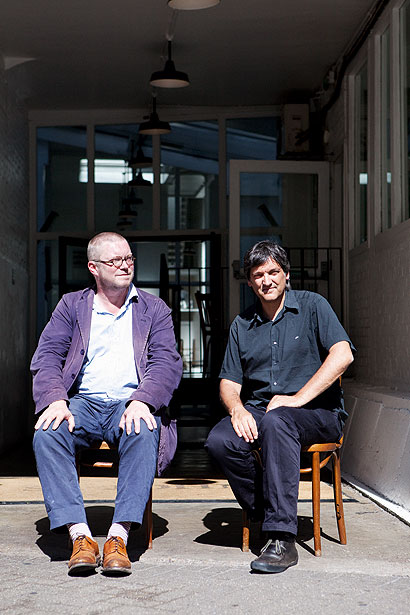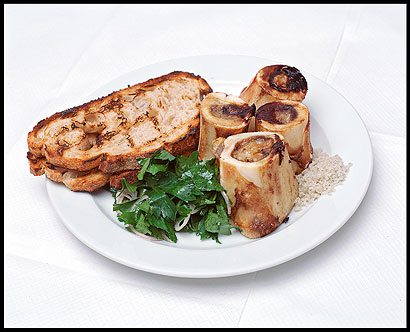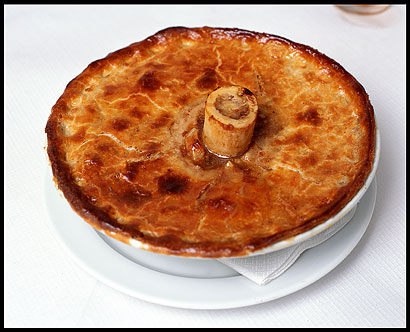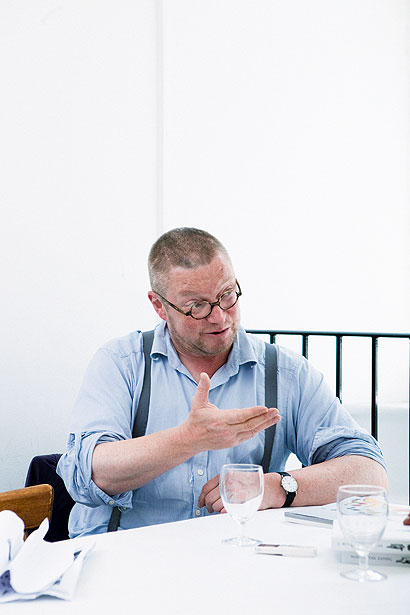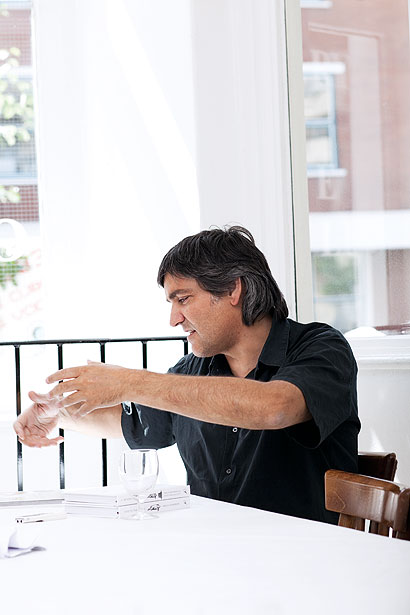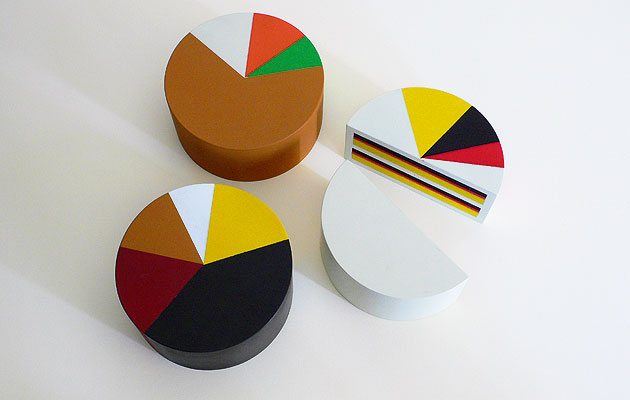|
Marti Guixé I call myself an ex-designer. And I understand that you are an ex-architect. Fergus Henderson Yes, that’s right. MG Why did you decide to go into the food business? FH Well, it was fate more than anything. I was training at the Architectural Association and all my buildings ended in theses … then I started doing recipes for buildings. But I thought, something’s not quite right. My mind was wandering in the wrong way. And then I took over a restaurant with some chums one Sunday, and we cooked. You know those Le Creuset pots? We managed to persuade them to give us 20 of those. We had tables of ten, so 200 people, with one pot per table, and I had a feeling that food was something quite important in my life. I finished architecture and was offered a job in a kitchen. So it wasn’t a conscious decision, it was something that arose.
Marti Guixé and Fergus Henderson (image: Peter Guenzel) MG But you cooked at the beginning? FH Yes, but not much any more. I’ve got two restaurants with head chefs in both. But I’m still involved in the design of them. And you? MG Fifteen years ago, in 1995, I was very interested in mass production. And I thought the most mass-produced object is food. People don’t see it as an object, they see it as food, but I started to see it as an object. I started to design what I call edible objects. I arrived at very strange work and I was in the media a lot in Barcelona in the 90s. It was also the moment when gastronomy was starting to be very popular. My food work went into museums and art galleries, but it never went into reality like yours. FH You know the artist Gary Hume? He’s a painter, and he makes very similar sculptures [to some of your food objects]. MG Oh really? I just approached food as if it were an object, so I designed it. People say these things are not appetising. FH Oh, well they work on me. MG There’s also some liquid models, that you drink, not eat. In Spain we have this gazpacho. Some of my things have a lot to do with the culture. This project [pointing to a Calvin Klein-branded tortilla in his book] is more conceptual. In Paleolithic times, people were eating from nature and they were not working, so I thought if we get sponsored food, then people can again go free through Europe, eating sponsored food for free, and then consumer society is the new nature. FH I like this notion that you feed the world by getting sponsorship. It’s fantastic. Not sure brands are quite into giving so much, but … MG I also made a piece where the ingredients of cakes were separated, like a pie chart. FH I love it. It’s hugely humorous. And I like it when the packaging becomes part of the food. The end result is very different from what I do but I think there’s the same spark. MG There are very subtle things too. Like I cut this channel in the lemon so you can use the lemon as an instrument to drop juice precisely.
Henderson’s bone marrow with parsley salad (image: Patricia Niven) FH Yes, it’s better than a lemon with its bottom chopped off [laughs]. I’ve always felt sorry for lemons having their bottoms chopped off. It looks like you’re having fun. I have fun here too. What’s this one? MG In 2005, a gallery asked me to redesign an opening night. I thought it would be nice not to have glasses and things, so I used this agricultural machine to create a gin fog. It breaks the molecules down with ultrasound. FH Brilliant. So you just breathe in. The problem is you don’t know whether it’s one or two or three large ones. MG Yes. People think that you can get drunk, but in fact you get very sticky because the air is sugary. OK [pointing at his book], this is something I did when I was working for Camper. They wanted to go into the hotel and restaurant business, fast food. They did the Food Ball restaurant, serving rice balls. I was consultant to the concept. And then this is an interesting thing I did in Amsterdam in 2005. The idea was to do a restaurant but we used outsourcing to get the food. So the waiter called takeaway companies. You had the menu with ten different types – Chinese, Mexican etc – they called the companies and they came inside, the scooter boys. There was no kitchen, which is very complicated to manage, and you outsource everything. You just sell the drinks. FH And then relax. MG Yes! But I like very much to eat British things. Because if you go around London you always have this multiculturalism. You have these generic kitchens, or Mediterranean. If I’m coming to London, I want to eat something British. You have these fish and chips, and this … FH All this strange, brown sticky food. Terrible. British food, my passion, has gone slightly awry. Which is weird because nature writes the menu for you. There are very short intense seasons. Like: native oysters, sea kale is the first greens of the year, mushrooms, asparagus, gulls’ eggs – two weeks they’re in season. And then in game season you have fantastic things from the sky. And so I don’t know why British food got so lost. If you look out the window it’ll tell you what to cook. We’ve embraced Mediterranean food, which is strange because, I mean, today is a beautiful day but it’s rare isn’t it? And so this notion that we have tomatoes ripe from the vine, it’s not us. So we took a funny curve. You know chicken kiev? Chicken breast boned out with garlic butter? We embraced that kind of thing too much. Everyone thought, ooh, garlic butter and breadcrumbs. We grab things too enthusiastically. But there’s hope, there’s hope. MG But chicken kiev is like a design object, a manufactured thing. FH Yes, and England embraced it. It laid back and said “chicken kiev me”. But Jamie Oliver has done good things with schools. It’s bizarre what we feed our children, the next generation. MG But did you discover these things or were you eating this kind of food when you were young? FH Mum’s a good cook. Which is important because there have been changes in this country, things are getting better food-wise, but I’m not sure eating at home has changed as much as we think. Restaurant-wise everything has changed but not at home. My mum is from Lancashire, which is vital. You’ll find most good British chefs’ mums are from Lancashire, I don’t know why but it’s an interesting fact. My Dad was a big eater. So it was all there. MG Yesterday I met a friend who told me your father was an architect too, no? He told me that in the 80s he had an office of 200 architects or something like that. FH Yes, it was a big practice: YRM – Yorke, Rosenberg and Mardall. They did Gatwick airport, all sorts. MG For you it’s better to do this than architecture? FH Yes, much. But architecture is very useful. And if you’re doing architecture you have to be very sure why you’re making gestures pertinent to a building, and it’s vital in the kitchen too: to say, why are you doing that? That kind of questioning is very useful. MG I am very critical of chefs. Because I think they are mostly practising craftsmanship. If I come [to St John] I see that behind it there’s more than a chef, there’s somebody more like an architect. Not in the interior but also in the things. It has a personality. Chefs usually follow some trend. FH Yes, normally it’s a fait accompli from the kitchen and the diner’s only involvement is to make a mess of it really. No, I thought, we’re not doing that. And we’ve removed all the gastronomic crutches: brassware, marble, fancy design, paintings. So in an architectural way, hopefully, it works. And then there are bones. MG The bones are very nice. They are like objects. FH They’re beautiful, and they also require you to get involved. So it affects your manner of occupation, which is what architecture is trying to do as well. So I feel very lucky, I’ve got people inside and out here. MG I enjoy it very much. It’s not so easy to go to a restaurant and to eat things where you think, “ah, that’s fantastic”. Also conceptually, not just delicious. In taste and in mind. FH Hopefully there’s a happy mind behind it all. But when chefs come for a job, they think, ah, this is simple. And then I say, “out you go”. Because actually we make life very difficult for ourselves by reducing it all down. But I love it, it’s fantastic, I think I’m much happier than I would be in an architect’s office. MG You’ve got two more restaurants? FH I’ve got one more, the same one, with a bakery, and we import wine. We opened, and everyone wanted it to be a restaurant, so it became, slightly organically, a restaurant, but it wasn’t the intent. There’s a third one on the way, a little hotel and restaurant in Chinatown, which will be lovely, but slightly more ambitious. Only 15 rooms. But I like the way the idea is a sort of table to bed. Do you know Isambard Kingdom Brunel? He was a Victorian engineer, he built the Great Western Railway to Bristol. And then he thought, right, we’ve got to Bristol, now for the Atlantic: let’s get people to America. We’ve fed people for 16 years, now we should put them to bed as well. Table to bed is our new venture. MG Is this a new business model? You offer something that nobody else is offering. FH We’ve been here 16 years, a long time. A lot of chefs work with me and then go on to do their own thing. But it’s very strange, it’s never proved to be a model that anyone wants to copy. So is it a new business model or not? I’m not sure. I don’t know if it’s good to be quite so perversely sure of yourself. MG But it’s very personal, you want it like that. In a way it’s your project. FH Yes. I have a business partner, Joe, who found the building and said to me, shall we do this, and he never questioned the food I cooked. It wasn’t a concept. It’s a slightly sad story this but I went to Sweden for an award. And they said, Fergus Henderson, we’re giving you an award for common sense cooking. And I thought, how dull does that sound? Common sense cooking. So I thought, there we go, dull old me. The strange thing is there is common sense in it. It’s hard to make common sense sound glamorous, but it’s using the whole animal, nose to tail cooking, following the seasons. MG In a way it looks like common sense but it’s something that is not normal. When I saw all the things we ate today I didn’t see this elaborate gastronomic thing, I saw more like objects. Your Welsh rarebit [cheese on toast] is like a product. All your dishes are like pieces, I like it, it’s not a mix of things. I thought, ah, this is someone who’s not a chef but an architect. It’s a feeling. It feels different to when I go to a Michelin restaurant. FH Well we have a Michelin star. Bizarrely! I don’t know why [laughs]. But it makes the chefs happy. MG Catalan food from farmers is also very basic. What you do is closer to that than the elaborate things they do in Valencia or Basque country. For me it’s closer than Italian. In Italy, everything’s very “cooked”, very refined. FH Ah, but Italy’s been a big influence on me. You have a slice of lamb on a plate, and that’s it. No more. Reduce it down. You’ve got a lot going on in Spain. I went recently with some chefs to El Bulli. MG Ah, Ferran Adria [the chef behind El Bulli] is opening a restaurant in front of my studio, a shellfish restaurant, nothing to do with El Bulli, kind of his own project. I’ve known him for years. FH He seems like a very nice chap. El Bulli is fun, which is fine, I can appreciate that, but it’s beyond twists and piles. It’s brilliant. MG Do you think if, hypothetically, you did a restaurant in Barcelona that you would do the same as here but with Barcelona basics? FH Well, we flirted with New York. But we thought if we go there it would change. Here’s home, where I was born and bred. I understand it. But yes, in Barcelona, the thing would be to have fun and use the basics.
Henderson’s pig pie (image: Patricia Niven) MG So you base it on a concept and then fit it into a context? FH Yes, you have to find the bakers and so on. It starts a whole lot of trouble. My favourite place in Barcelona is Bar Bomba. They do these things with lard, it’s fantastic. MG Also in Barcelona there is a place where you can eat the bones of a fish. They take anchovy bones and they fry them so that they are crispy. They open the anchovy and instead of throwing away the bones they fry them. This is a local thing, and it’s very popular but not that available. If you go into basic countryside cooking there are still some things from the old times. FH It’s very strange, if you leave London the food changes utterly, yet there are weird, good things, like bones. Did you ever see the film La Grande Bouffe? Where Marcelo Mastroianni and others try to eat themselves to death? I nipped off one afternoon to this very little cinema and it was very strange, there was this foody dirty-mac brigade all sitting separately. And I made a comparison with the dishes we could make at St John. And my friend said, what do you mean? You should serve chips, that’s what everyone wants. And I said, no, we’re not going to do chips, we’re going to do bones! It was a very good moment. My theory is that – stop me if I’m rambling on – I’ve never worked for anyone else, I’ve always had my own kitchen. And I’m a great believer in not sleeping under your oven, or living in your kitchen, close to your art. It isn’t healthy. You need to breathe fresh air, go and eat someone else’s food, go to the movies, read a book. Because you don’t know when something’s going to strike you. If you go to sleep under your oven, and then you have to cook again, the same dish, and try to replicate the master, it’s not a healthy arrangement. But you’ve certainly gone off on your own tangent, which is fantastic. I like the Hands-free Lollipop [a lollipop with three sticks that form a tripod so it can be freestanding]. MG That’s because for a lot of people that’s the most simple object, no? How can you improve it? But you also write books? FH I write books, yes, but I find it very hard. MG Do you think I should open a restaurant to do all these things or should it just remain a conceptual project? FH It’s tricky. MG I now have the possibility to rent a space near my studio. The area would be great because Ferran Adria is opening there. But I don’t know, it’s a hard business to run a restaurant. FH It is. MG So I don’t know if I’d do it well. Also I don’t believe this is very popular. It’s more conceptual.
Henderson at St John (image: Patricia Niven) FH There are moments when the conceptual becomes actual. But then with a restaurant you have a wine list – how do you choose the wine? And you have waiters who have certain attitudes. There’s more than you think. No, I think you should do feasts. Have “moments”. Definitely. MG I call this Spamt [pointing to his book]. It’s a tomato filled with ketchup – natural tomato filled with artificial tomato. It’s an experience to eat that. I tried to eat it once. FH Why did you call it Techno Tapas? MG Because it is this kind of tapas that you can eat in extreme conditions of contemporary life. For example under water – the most extreme condition is under water. So I went to the sea with an underwater camera and I have pictures of eating Techno Tapas under water. It was salty, so it was good. But it was a little bit difficult to breathe. FH Yes, you’re chewing and then … maybe that’s taking multi-tasking a bit far [laughs]. MG I thought, if you’re working everywhere with mobile phones, why can’t you eat everywhere, in any conditions? FH Do you only deal with food or do you still do other things? MG No, I do other things. That’s only one part of my work. Let’s say maybe the more experimental part. But I do interior design and product design. Chair and furniture design. I believed a lot in food design at the beginning but it didn’t turn into the real thing. I didn’t want to put it into restaurants, it didn’t happen. I believe now every school does food design as a discipline. In 1995 it was a rarity. In ten years maybe industrial food will be really unusual. Anyway, I’ve had the opportunity through my work to know all these chefs and I am interested in food, but I don’t cook and I have no idea of cooking. I am not so interested in gastronomy. I am more interested in popular things, business things. FH Yes, I can see. It’s not my kind of speciality on a plate, it’s the opposite. You’ve taken something very popular and made it so you can eat it under water. It’s brilliant.
Guixé at St John (image: ©Imagekontainer/Knölke) MG Anyway, I was asking because people always say, ah, you don’t have a restaurant, but I don’t need a restaurant. FH If you had a restaurant it would probably bring it all down to earth too much. You’re free to fly. Your thoughts, off they go. And these are peas with ladies on them [pointing to Guixé’s book] … MG These are organic peas with images of ladies from before the time of plastic surgery. Now there are a lot of stars who use plastic surgery. So to define that the peas are organic and natural, I put icons of women who didn’t use plastic surgery. FH The word organic is abused terribly. It’s like in American police films: there’s a crime scene, and the FBI arrive and say, back off, FBI! It’s like, back off, organic. You get weird things like avocado pears from Chile, and it’s organic, but how did it get here? I think that’s much better than organic, having pictures of ladies with no plastic surgery. MG This idea of making comparisons between people and food … in the past people were not using plastic surgery and food was automatically organic. Fergus, do you still follow the architecture world at all? FH Not too much. MG They seem to come to you. You had Robert AM Stern having lunch here today. FH Oh really? Right. It’s nice to have artists and architects passing through. |
Portrait Peter Guenzel |
|
|
||
|
Guixé’s I-Cakes, 2001(image: ©Imagekontainer/Knölke) |
||

